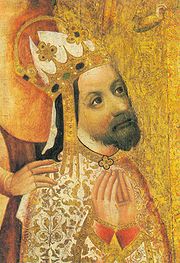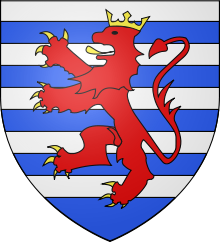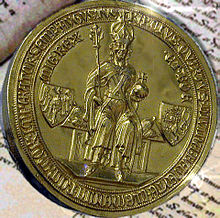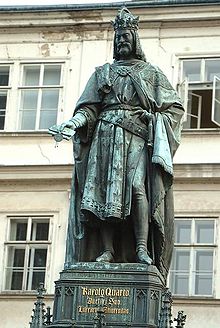- Charles IV, Holy Roman Emperor
-
Charles IV 
King of Bohemia, Count of Luxemburg Reign 26 August 1346–29 November 1378 Coronation 2 September 1347, Prague Predecessor John of Bohemia Successor Wenceslaus King of the Romans (King in Germany) Reign 11 July 1346–29 November 1378 Coronation 26 November 1346, Bonn Predecessor Louis IV, Holy Roman Emperor Successor Wenceslaus I Holy Roman Emperor, King of Italy Reign 6 January/5 April 1355–29 November 1378 Coronation 6 January 1355, Milan (Italian royal)
5 April 1355, Rome (imperial)Predecessor Louis IV Successor Sigismund I King of Burgundy Reign 4 June 1365–29 November 1378 Coronation 4 June 1365, Besançon Successor Sigismund I Spouse Blanche of Valois
Anna of Bavaria
Anna von Schweidnitz
Elizabeth of PomeraniaIssue Sigismund, Holy Roman Emperor
Wenceslaus, King of the Romans
Margaret, Queen of Hungary
Catherine of Bohemia
Elisabeth, Duchess of Austria
Anne, Queen of England
Margaret of Bohemia, Burgravine of NurembergHouse House of Luxemburg Father John of Bohemia Mother Elisabeth of Bohemia Born 14 May 1316
PragueDied 29 November 1378 (aged 62)
PragueReligion Roman Catholicism Charles IV (Czech: Karel IV., German: Karl IV, Latin: Carolus IV) (14 May 1316, Prague – 29 November 1378), born Wenceslaus (Václav), was the second king of Bohemia from the House of Luxembourg, and the first king of Bohemia to also become Holy Roman Emperor.
He was the eldest son and heir of John the Blind, who died (in the Battle of Crécy) on 26 August 1346. Charles inherited the County of Luxembourg and the Kingdom of Bohemia. On 2 September 1347 Charles was crowned King of Bohemia.
On 11 July 1346 Prince-electors had elected him King of the Romans (rex Romanorum) in opposition to Emperor Louis IV. Charles was crowned on 26 November 1346 in Bonn. After his opponent had died, he was re-elected in 1349 (17 June) and crowned (25 July) King of the Romans. In 1355 he was also crowned King of Italy on 6 January and Holy Roman Emperor on 5 April. With his coronation as King of Burgundy, delayed until 4 June 1365, he became the personal ruler of all the kingdoms of the Holy Roman Empire.
Contents
Life
Born to John and Elisabeth of Bohemia (1292–1330) in Prague as Wenceslaus (Václav), the name of her father, but later chose the name Charles at his confirmation after he went to France, at the court of his uncle, Charles IV of France, where he remained for seven years.
Charles received French education and was literate and fluent in five languages: Latin, Czech,[1] German, French, and Italian. In 1331 he gained some experience of warfare in Italy with his father. From 1333 he administered the lands of the Bohemian Crown due to his father's frequent absence and later also deteriorating eyesight. In 1334, he was named Margrave of Moravia, the traditional title for the heirs to the throne. Two years later he undertook the government of Tirol on behalf of his brother John Henry, and was soon actively concerned in a struggle for the possession of this county.
King of the Romans
In consequence of an alliance between his father and Pope Clement VI, the relentless enemy of the emperor Louis IV, Charles was chosen Roman king in opposition to Louis by some of the prince-electors at Rhens on 11 July 1346. As he had previously promised to be subservient to Clement he made extensive concessions to the Pope in 1347. Confirming the papacy in the possession of wide territories, he promised to annul the acts of Louis against Clement, to take no part in Italian affairs, and to defend and protect the church.
Charles IV was initially in a very weak position in Germany. Owing to the terms of his election, he was derisively referred to by some as a "priest's king" (Pfaffenkönig). Many bishops and nearly all of the Imperial cities remained loyal to Louis the Bavarian. Worse yet, Charles backed the wrong horse in the Hundred Years' War, losing his father and many of his best knights at the battle of Crecy in August 1346, with Charles himself escaping wounded from the field.
Civil War in Germany was prevented, however, when Louis IV died on 11 October 1347, when he suffered a stroke during a bear-hunt. In January 1349 Wittelsbach partisans attempted to secure the election of Günther von Schwarzburg as king, but he attracted few supporters and died unnoticed and unmourned after a few months. Thereafter, Charles faced no direct threat to his claim to the Imperial throne.
Charles initially worked to secure his power base. Bohemia had remained untouched by the plague. Prague became his capital, and he rebuilt the city on the model of Paris, establishing the New Town of Prague (Nové Město). In 1348, he founded the University of Prague, named after him, the first university in Central Europe. This served as a training ground for bureaucrats and lawyers. Soon Prague emerged as the intellectual and cultural center of Central Europe.
Holy Roman Emperor 

Coats of arms
Charles, having made good use of the difficulties of his opponents, was again elected and recrowned at Aachen on 25 July 1349, and was soon the undisputed ruler of the Empire. Gifts or promises had won the support of the Rhenish and Swabian towns; a marriage alliance secured the friendship of the Habsburgs; and that of Rudolf II of Bavaria, count palatine of the Rhine, was obtained when Charles, who had become a widower in 1348, married his daughter Anna.In 1350 the king was visited at Prague by the Roman tribune Cola di Rienzo, who urged him to go to Italy, where the poet Petrarch and the citizens of Florence also implored his presence.[2] Turning a deaf ear to these entreaties, Charles kept Cola in prison for a year, and then handed him as a prisoner to Clement at Avignon.
Outside of Prague, Charles attempted to expand the Bohemian crown lands, using his imperial authority to acquire fiefs in Silesia, the Upper Palatinate, and Franconia. The latter regions comprised "New Bohemia", a string of possessions intended to link Bohemia with the Luxemburg territories in the Rhineland. The Bohemian estates were not, however, willing to support Charles in these ventures. When Charles sought to codify Bohemian law in the Majestas Carolina of 1355 he met with sharp resistance. After that point, Charles found it expedient to scale back his efforts at centralization.
Holy Roman Emperor
In 1354 he crossed the Alps without an army, received the Lombard crown in St. Ambrose Basilica, Milan on 5 January 1355, and was crowned emperor at Rome by a cardinal in the April of the same year.[3] His sole object appears to have been to obtain the imperial crown in peace, and in accordance with a promise previously made to Pope Clement. He only remained in the city for a few hours, in spite of the expressed wishes of the Roman people. Having virtually abandoned all the imperial rights in Italy, the emperor recrossed the Alps, pursued by the scornful words of Petrarch but laden with considerable wealth.[4] On his return Charles was occupied with the administration of the Empire, then just recovering from the Black Death, and in 1356 he promulgated the famous Golden Bull to regulate the election of the king.
Having given Moravia to one brother, John Henry, and erected the county of Luxemburg into a duchy for another, Wenceslaus, he was unremitting in his efforts to secure other territories as compensation and to strengthen the Bohemian monarchy. To this end he purchased part of the upper Palatinate of the Rhine in 1353, and in 1367 annexed Lower Lusatia to Bohemia and bought numerous estates in various parts of Germany. On the death in 1363 of Meinhard, duke of Upper Bavaria and count of Tirol, Upper Bavaria was claimed by the sons of the emperor Louis IV, and Tirol by Rudolf IV, Duke of Austria.
Both claims were admitted by Charles on the understanding that if these families died out both territories should pass to the house of Luxemburg. About the same time he was promised the succession to the Margravate of Brandenburg, which he actually obtained for his son Wenceslaus in 1373. He also gained a considerable portion of Silesian territory, partly by inheritance through his third wife, Anna von Schweidnitz, daughter of Henry II, Duke of Świdnica and Catherine of Hungary. In 1365 Charles visited Pope Urban V at Avignon and undertook to escort him to Rome; and on the same occasion was crowned King of Burgundy at Arles.
 Meeting with Charles V of France in Paris in 1378, from a fifteenth-century manuscript in the Bibliothèque de l'Arsenal
Meeting with Charles V of France in Paris in 1378, from a fifteenth-century manuscript in the Bibliothèque de l'Arsenal
His second journey to Italy took place in 1368, when he had a meeting with Pope Urban VI at Viterbo, was besieged in his palace at Siena, and left the country before the end of the year 1369. During his later years the emperor took little part in German affairs beyond securing the election of his son Wenceslaus as king of the Romans in 1376, and negotiating a peace between the Swabian league and some nobles in 1378. After dividing his lands between his three sons, he died in November 1378 at Prague, where he was buried, and where a statue was erected to his memory in 1848.
Charles IV suffered from gout (metabolic arthritis), a painful disease quite common in that time.
Evaluation and legacy
His reign was characterised by a transformation in the nature of the Empire and is remembered as the Golden Age of Bohemia. He promulgated the Golden Bull of 1356 whereby the succession to the imperial title was laid down, which held for the next four centuries.
He also organized the states of the empire into peace-keeping confederations. In these, the Imperial cities figured prominently. The Swabian Landfriede confederation of 1370 was made up almost entirely of Imperial Cities. At the same time, the leagues were organized and led by the crown and its agents. As with the electors, the cities which served in these leagues were given privileges to aid them in their efforts to keep the peace.
He assured his dominance over the eastern borders of the Empire through succession treaties with the Habsburgs and the purchase of Brandenburg. He also claimed imperial lordship over the crusader states of Prussia and Livonia.
Patronage of culture and the arts
He made Prague the imperial capital, refusing even at the insistence of Petrarch to move to Rome, and he was a great builder in that city, which bears his name in so many spots: Charles University, Charles Bridge, and Charles Square. Prague Castle and much of the cathedral of Saint Vitus, by Peter Parler, were completed under his patronage. Finally, it is from the reign of Charles that dates the first flowering of manuscript painting in Prague. In the present Czech Republic, he is still regarded as Pater Patriae (father of the country or otec vlasti), a title first coined by Adalbertus Ranconis de Ericinio at his funeral.
Charles IV also had strong ties to Nuremberg, staying within its city walls 52 times and thereby strengthening its reputation amongst German cities. Charles was the patron of the Nuremberg Frauenkirche, built between 1352 and 1362 (the architect was likely Peter Parler), where the imperial court worshiped during its stays in Nuremberg.
Charles's imperial policy was focused on the dynastic sphere and abandoned the lofty ideal of the Empire as a universal monarchy of Christendom. In 1353, he granted Luxembourg to his nephew Jobst. He concentrated his energies chiefly on the economic and intellectual development of Bohemia, where he founded the university in 1348 and encouraged the early humanists. Indeed, he corresponded with Petrarch, whom he invited to visit his residence in Prague, but the great Italian hoped — to no avail — to see Charles move his residence to Rome and reawaken tradition of the Roman Empire.
Charles's sister Bona, married the eldest son of Philip VI of France, the future John II of France, in 1335. Thus, Charles was the maternal uncle of Charles V of France, who solicited his relative's advice at Metz in 1356 during the Parisian Revolt. This family connection was celebrated publicly when Charles IV made a solemn visit to his nephew in 1378, just months before his death. A detailed account of the occasion, enriched by many splendid miniatures, can be found in Charles V's copy of the Grandes Chroniques de France.
Genealogy
Henry VII
12 July 1275(6) – 24 August 1313Margaret of Brabant
4 October 1276 – 14 December 1311Wenceslaus II
27 September 1271 – 21 June 1305Judith of Habsburg
13 March 1271 – 18 June 1297John of Bohemia
10 August 1296 – 26 August 1346Elisabeth of Bohemia
20 January 1292 – 28 September 13301
Blanche of Valois
1316 – 1 August 1348
OO 15 May 13232
Anna of Bavaria
26 September 1329 – 2 February 1353
OO March 1349Charles IV
14 May 1316 – 29 November 13783
Anna von Schweidnitz
1339 – 11 July 1362
OO 27 May 13534
Elizabeth of Pomerania
1346(7) – 14 February 1393
OO 21 May 13631 1 2 3 3 3 4 son
b.1334Margaret of Bohemia
1335–49Catherine of Bohemia
1342–95Wenceslas
1350–51Elisabeth of Bohemia
1358–73Wenceslaus,
King of the Romans
1361–1419son
1362Anne
of Bohemia
1366–944 4 4 4 4 Sigismund, Holy Roman Emperor
1368–1437John of Görlitz
1370–96Charles
1372–73Margaret of Bohemia
1373–1410Henry
1377–78Family and children
Charles was married four times. His first wife was Blanche, (1316–48), daughter of Charles, Count of Valois, a half-sister of Philip VI of France. They had three children:
- a son (b.1334), died young [5]
- Margaret, who married Louis I of Hungary
- Catherine (1342–95), who married Rudolf IV of Austria and Otto V, Duke of Bavaria, Elector of Brandenburg
He secondly married Anna of Bavaria, (1329–53), daughter of the Count Palatine Rudolph II and they had one son,
- Wenceslaus (1350–51).
His third wife was Anna von Schweidnitz, (1339–62), daughter of Henry II, Duke of Świdnica and Katharina of Anjou (daughter of Charles I Robert, King of Hungary), by whom he had three children,
- Elisabeth (19 April 1358–4 September 1373), who married Albert III of Austria.
- Wenceslaus (1361–1419), Charles's successor as Emperor and king of Bohemia, and married firstly to Joanna of Bavaria in 1370 and secondly to Sophia of Bavaria in 1389.
- son (b. and d. 11 July 1362).
His fourth wife was Elizabeth of Pomerania, (1345 or 1347–1393), daughter of Duke Bogislaw V, Duke of Pomerania and Elisabeth, daughter of Casimir III of Poland. They had six children:
- Anne (1366–94), who married Richard II of England
- Sigismund (1368–1437), emperor, king of Hungary and Bohemia and margrave of Brandenburg, married firstly to Mary of Hungary in 1385 and secondly to Barbara of Cilli in 1405/1408.
- John (1370–96), margrave of Moravia and duke of Görlitz, who married Richardis Catherine of Sweden.
- Charles (13 March 1372–24 July 1373).
- Margaret (1373–1410), who married John III, Burgrave of Nuremberg.
- Henry (1377–78)
Named after Charles IV
Several places have been named after Charles:
- Karlstein Castle and the nearby village Karlštejn (Beroun District)
- Kašperk Castle
- Karlsfried Castle
- Carlsbad (several places)
- 16951 Carolus Quartus (an asteroid)
- Charles Bridge (Karlův most)
- Charles Square (Karlovo náměstí)
- Charles University in Prague (Karlova Univerzita)
Ancestry
Ancestors of Charles IV, Holy Roman Emperor 16. Henry V, Count of Luxembourg 8. Henry VI, Count of Luxembourg 17. Margaret of Bar 4. Henry VII, Holy Roman Emperor 18. Baudoin d'Avesnes 9. Beatrice d'Avesnes 19. Felicite de Coucy 2. John I of Bohemia 20. Henry III, Duke of Brabant 10. John I, Duke of Brabant 21. Adelaide of Burgundy 5. Margaret of Brabant 22. Guy of Dampierre 11. Margaret of Flanders 23. Matilda de Bethune 1. Charles IV, Holy Roman Emperor 24. Wenceslaus I of Bohemia 12. Ottokar II of Bohemia 25. Kunigunde of Hohenstaufen 6. Wenceslaus II of Bohemia 26. Rostislav Mikhailovich 13. Kunigunda of Slavonia 27. Anna of Hungary 3. Elisabeth of Bohemia 28. Albert IV, Count of Habsburg 14. Rudolph I of Germany 29. Heilwig of Kiburg 7. Judith of Habsburg 30. Burchard III of Hohenberg 15. Gertrude of Hohenburg 31. Mechtild of Tübingen See also
References
- ^ Vita Caroli
- ^ Francesco Petrarca Epistolae familiares X.1, XII.1, XVIII.1; See also: E.H. Wilkins Life of Petrarch (Chicago, 1961) 97, 112, 134 resp.
- ^ František Palacký: Dějiny národu českého v Čechách i v Moravě, books VIII and IX
- ^ Francesco Petrarca: Epistolae familiares XIX.12; See also E.H. Wilkins Life of Petrarch (Chicago, 1961) 147
- ^ Bohemia, Medieval Lands
- Charles IV (autobiography), edited by Balázs Nagy, Frank Schaer: Autobiography of Emperor Charles IV; And, His Legend of St. Wenceslas: Karoli IV Imperatoris Romanorum Vita Ab Eo Ipso Conscripta; Et, Hystoria Nova de Sancto Wenceslao Martyre, Published by Central European University Press, 2001, ISBN 9639116327, 9789639116320, 259 pages, books.google.com
 This article incorporates text from a publication now in the public domain: Chisholm, Hugh, ed (1911). Encyclopædia Britannica (11th ed.). Cambridge University Press.
This article incorporates text from a publication now in the public domain: Chisholm, Hugh, ed (1911). Encyclopædia Britannica (11th ed.). Cambridge University Press.
Charles IV, Holy Roman EmperorBorn: 14 May 1316 Died: 29 November 1378 [aged 62]Preceded by
JohnCount of Luxembourg
1346–78Succeeded by
WenceslausKing of Bohemia
1346–78Preceded by
Louis IVGerman King
(formally King of the Romans)
1346–78
(until 1347 in opposition to Louis IV)King of Italy
1355–78King of Burgundy
1365–78Holy Roman Emperor
1355–78Succeeded by
SigismundPreceded by
Otto VMargrave of Brandenburg
1373–78Monarchs of Bohemia Přemyslid Bořivoj I · Spytihněv I · Vratislaus I · Wenceslaus I · Boleslaus I · Boleslaus II · Boleslaus III · Vladivoj · Boleslaus III · Boleslaus the Brave1 · Jaromír · Ulrich · Jaromír · Ulrich · Bretislaus I · Spytihněv II · Vratislaus II · Conrad I · Bretislaus II · Bořivoj II · Svatopluk · Vladislaus I · Bořivoj II · Vladislaus I · Sobeslaus I · Vladislaus II · Frederick · Sobeslaus II · Bedřich · Conrad II · Wenceslaus II · Ottokar I · Bretislaus III · Vladislaus III · Ottokar I 2 · Wenceslaus I · Ottokar II · Wenceslaus II · Wenceslaus IIINon-dynastic 1306–1310Henry the Carinthian · Rudolph I · Henry the CarinthianLuxembourg 1310–1437Habsburg 1437–1457Non-dynastic 1457–1471Jagiellon 1471–1526Vladislaus II · LouisHabsburg 1526–1780Ferdinand I · Maximilian · Rudolph II · Matthias II · Ferdinand II · Frederick · Ferdinand III · Ferdinand IV · Leopold I · Joseph I · Charles II · Charles Albert3 · Maria TheresaHabsburg-Lorraine 1780–1918Monarchs of Germany Eastern Francia (843–918) 
Saxon Kingdom (919–62) Kingdom of Germany
in the Holy Roman Empire
(962–1806)Otto I • Otto II • Otto III • Henry II • Conrad II • Henry III • Henry IV • Henry V • Lothair III • Conrad III • Frederick I • Henry VI • Philip • Otto IV • Frederick II • Conrad IV • Rudolf I • Adolf • Albert I • Henry VII • Louis IV • Charles IV • Wenceslaus • Rupert • Sigismund • Albert II • Frederick III • Maximilian I • Charles V • Ferdinand I • Maximilian II • Rudolph II • Matthias • Ferdinand II • Ferdinand III • Leopold I • Joseph I • Charles VI • Charles VII • Francis I • Joseph II • Leopold II • Francis IIConfederation of the Rhine (1806–1813) Napoleon IGerman Confederation (1815–1848) German Empire (1849) German Confederation (1850–1866) North German Confederation (1867–1871) German Empire (1871–1918) Monarchs of Luxembourg Counts of Luxembourg (963–1354)  Henry V (1247–1281) · Henry VI (1281–1288) · Henry VII (1288–1313) · John I (1313–1346) · Charles I (1346–1353) · Wenceslaus I (1353–1354)
Henry V (1247–1281) · Henry VI (1281–1288) · Henry VII (1288–1313) · John I (1313–1346) · Charles I (1346–1353) · Wenceslaus I (1353–1354)Dukes of Luxembourg (1354–1794) Wenceslaus I (1354–1383) · Wenceslaus II (1383–1388) · Jobst (1388–1411) · Elisabeth (1411–1443) with · Anthony (1411–1415), and then · John II (1418–1425) Philip II (1482–1506) · Charles III (1506–1556) · Philip III (1556–1598) · Isabella Clara Eugenia (1598–1621) and Albert (1598–1621) · Philip IV (1621–1665) · Charles IV (1665–1700)House of Habsburg-Lorraine
Philip II (1482–1506) · Charles III (1506–1556) · Philip III (1556–1598) · Isabella Clara Eugenia (1598–1621) and Albert (1598–1621) · Philip IV (1621–1665) · Charles IV (1665–1700)House of Habsburg-Lorraine
(1780–1794)Grand Dukes of Luxembourg (since 1815)  Adolphe (1890–1905) · William IV (1905–1912) · Marie-Adélaïde (1912–1919) · Charlotte (1919–1964) · Jean (1964–2000) · Henri (since 2000)Categories:
Adolphe (1890–1905) · William IV (1905–1912) · Marie-Adélaïde (1912–1919) · Charlotte (1919–1964) · Jean (1964–2000) · Henri (since 2000)Categories:- 1316 births
- 1378 deaths
- People from Prague
- 14th-century Luxembourgian people
- 14th-century Czech people
- 14th-century French people
- 14th-century German people
- Bohemian princes
- Bohemian monarchs
- Roman Catholic monarchs
- Luxembourgian dynasty
- Counts of Luxembourg
- Electors of Brandenburg
- Holy Roman Emperors
- Czech people of Luxembourgian descent
- Czech expatriates in France
- Czech people of French descent
- Burials at St. Vitus Cathedral
- Charles IV, Holy Roman Emperor
Wikimedia Foundation. 2010.





